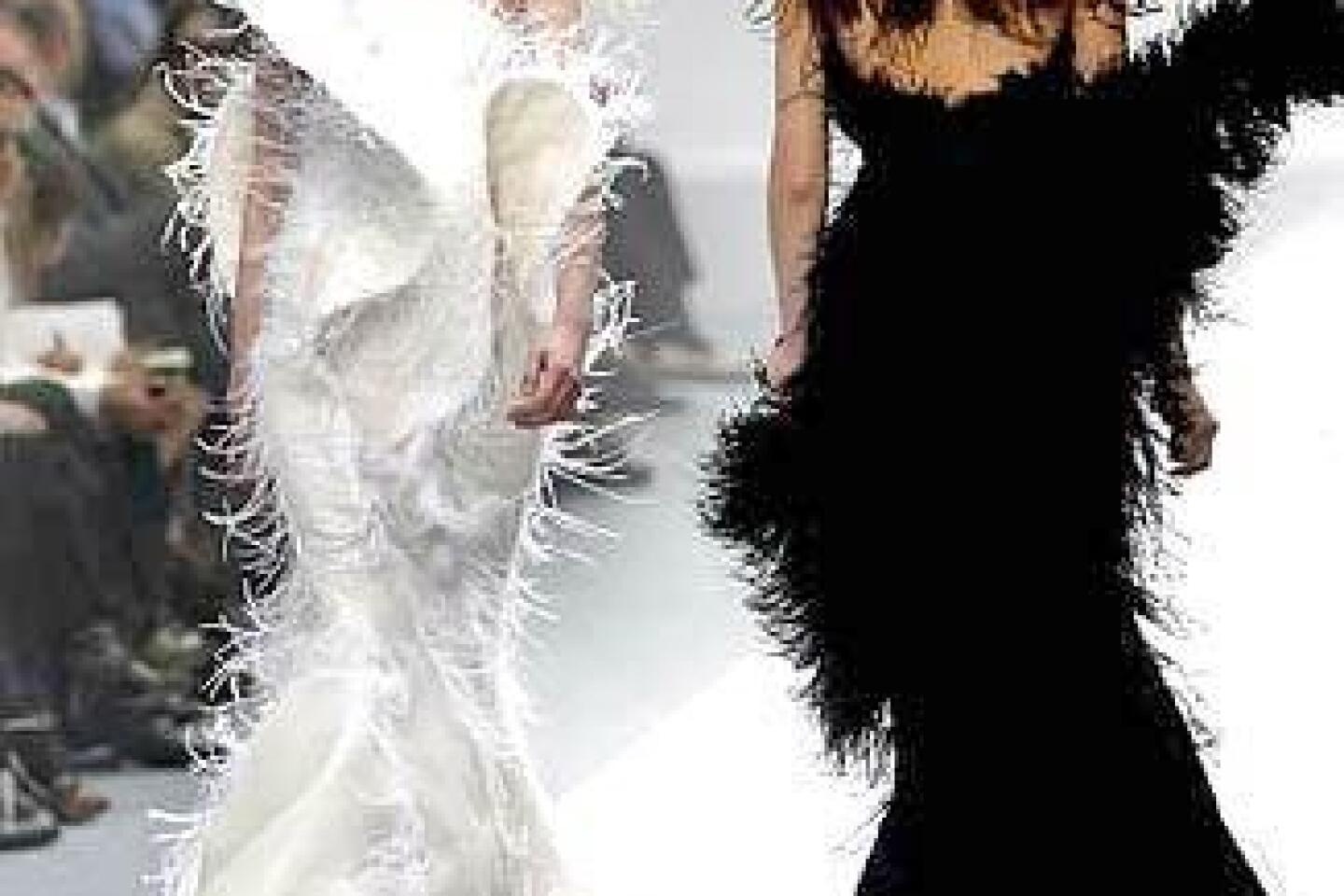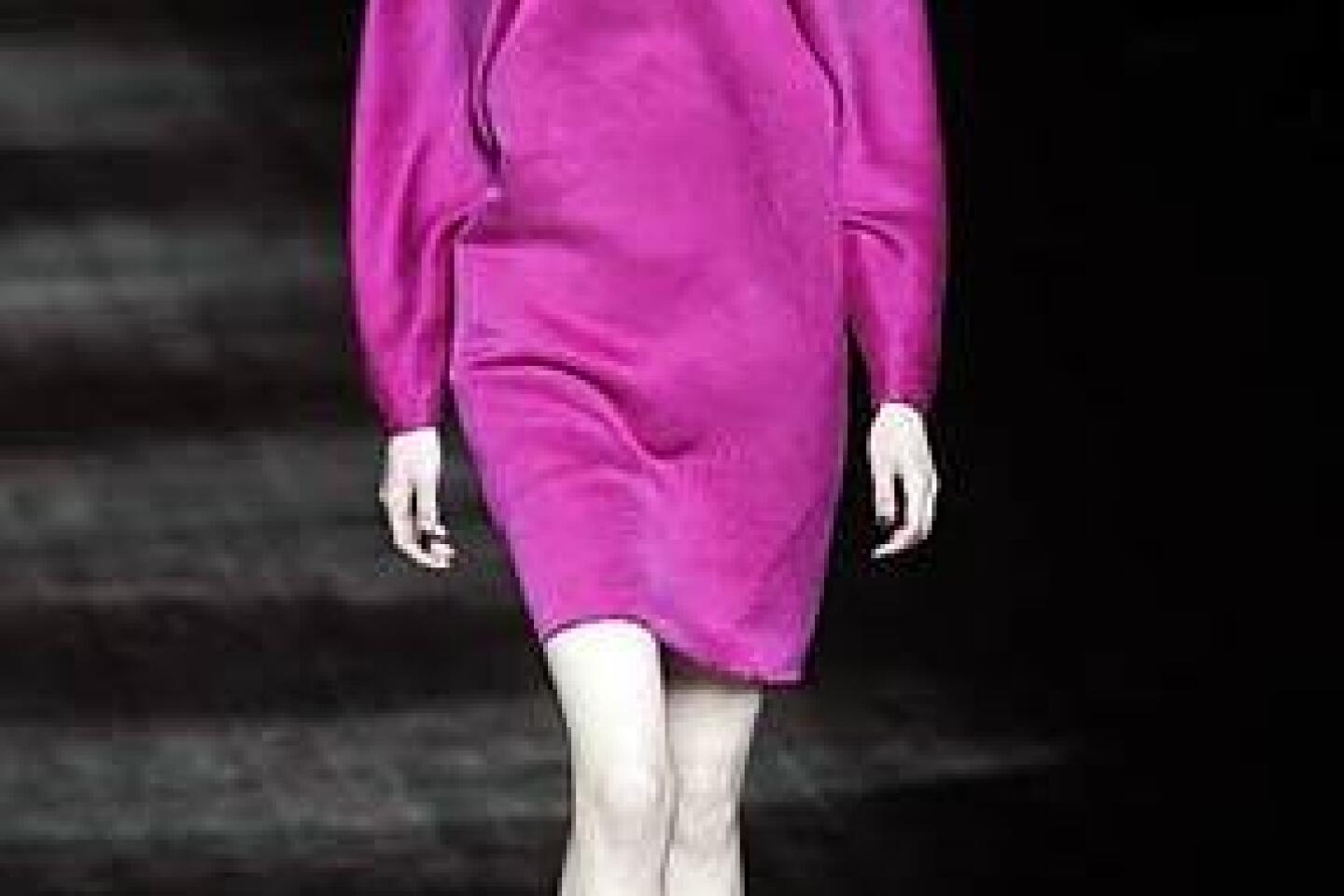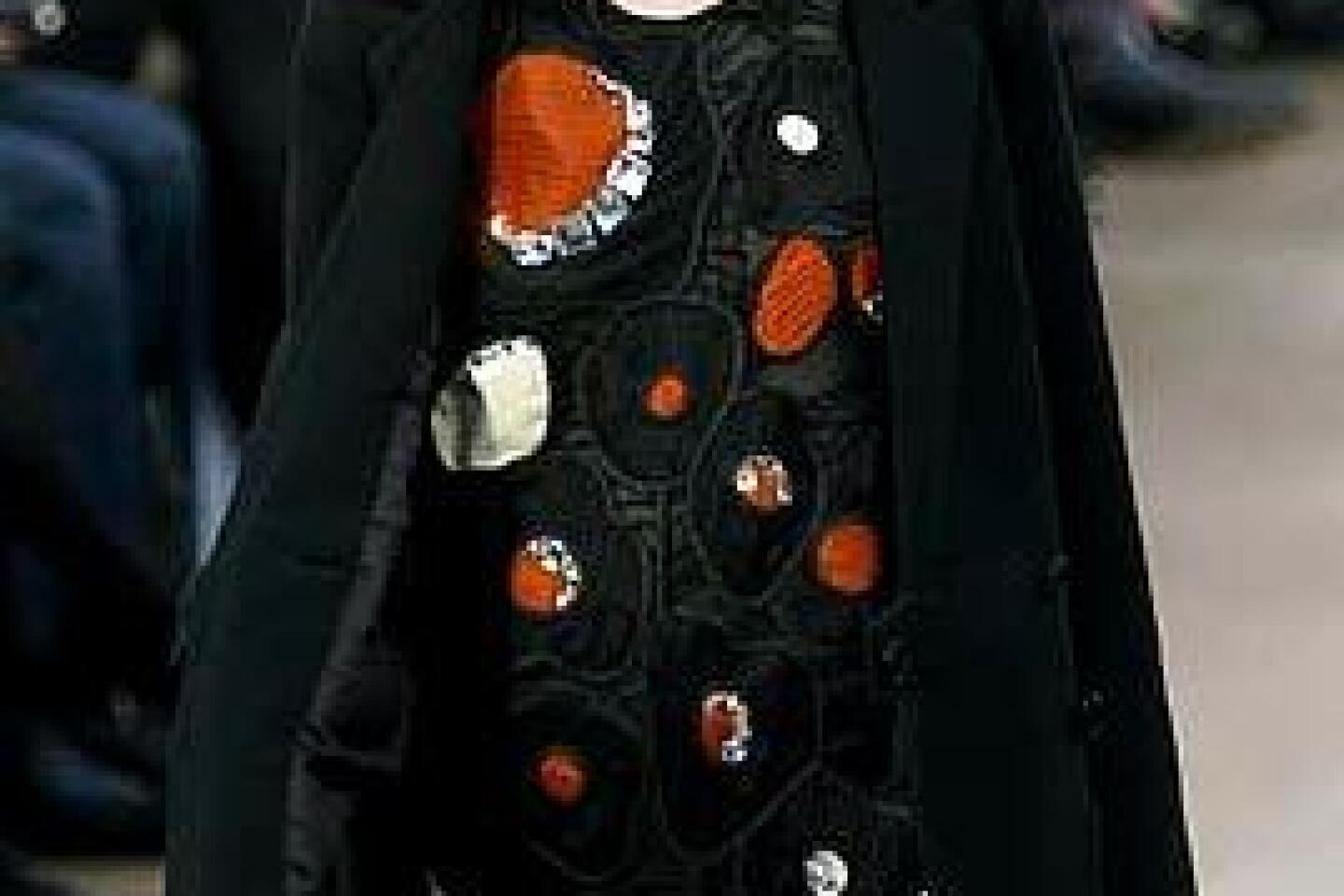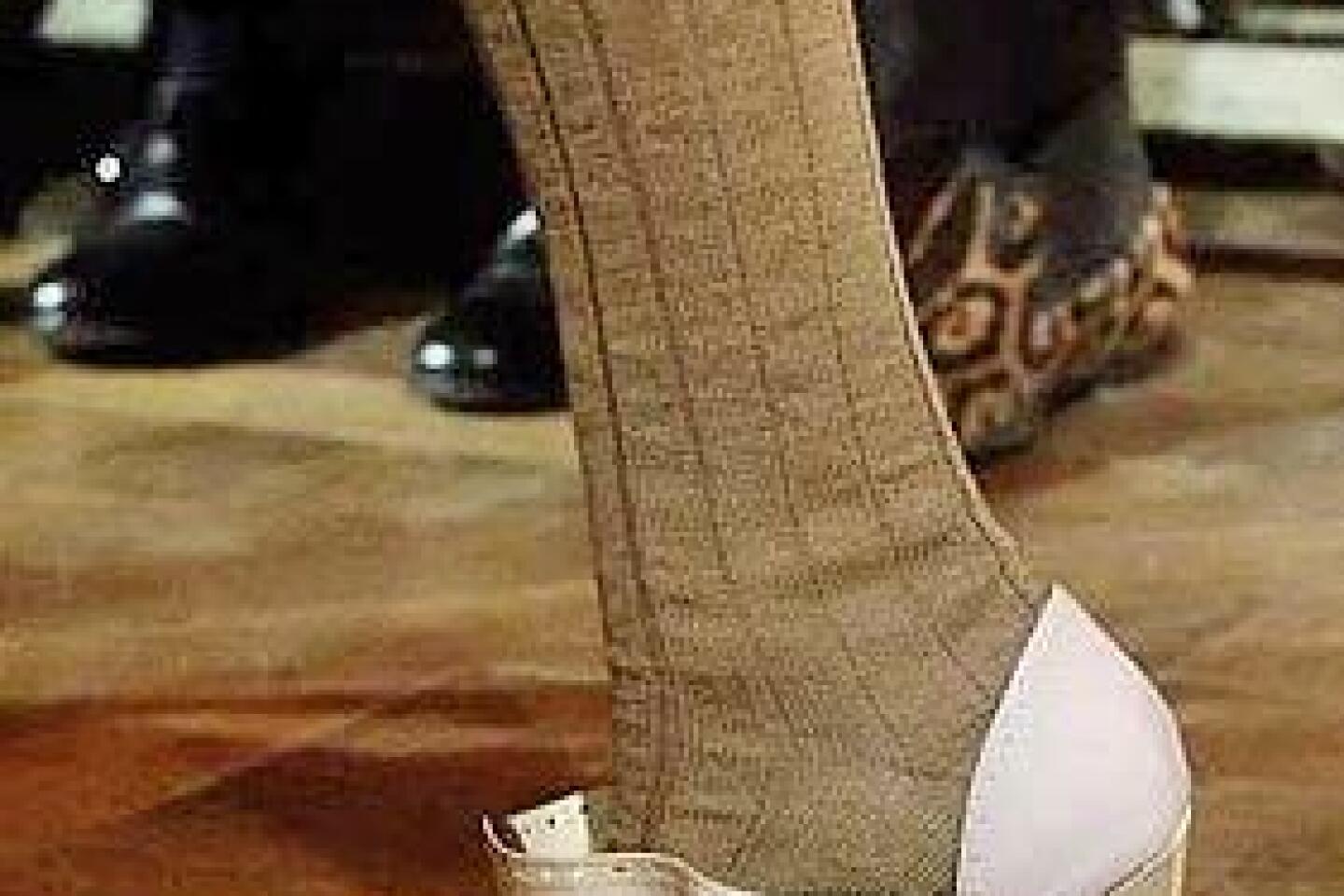Paris shows reveal a return to pure design
- Share via
PARIS — Now that LVMH and Gucci Group have taken over storefronts in every corner of the globe, pushing the same merchandise in L.A. and Shanghai, fashion is in danger of losing its allure. Over-the-top, expensive materials don’t even register anymore because everyone can have them. Fast fashion outlets are adding another level of competition.
So designers are turning to selling the experience of good design. They are reminding us that their gestures — the placement of a dart or a flower appliqué, treating leather like a synthetic or shaving fur into a pattern resembling crocodile scales — are what define fashion.
As the Paris shows came to an end here on Sunday, this new, more thoughtful approach to luxury was never more clear. It is partly a reaction against the last few crystal-studded go-go years and a return to the pure design that made Japanese talents such as Rei Kawakubo and Yohji Yamamoto so important in the 1990s. But it also requires a customer to want a quieter elegance, to equate luxury with good craftsmanship and subtle design — and that’s no small risk. It’s a lot easier to justify spending $2,000 on a logo and some flash.
“If I went to the moon, where would I go next?,” Alber Elbaz posed in the show notes for his superb Lanvin collection. It was a provocative question in this age when anything is possible, available, for sale 24 hours a day and in a season that follows on the heels of spring’s fascination with futurism. His answer was “home.” And that is why Elbaz’s clothes are so special. They are intimate. Even on a 50-foot runway, with rows of people on either side, or in a department store bursting with racks of clothes, it’s just you and him.
Elbaz’s collection was sharp, decisive and confident, and you couldn’t help but be taken by it. He created a new silhouette with sculpted sleeves, not the 1980s variety but more architectural, a kind of abstracted leg o’ mutton, narrow set on a fuchsia duchesse satin chemise, and again on a lovely creamy white charmeuse blouse. Sleeveless silk shifts in purple, pink, red or black looked simple in front, only to explode into a wave of frills or get swept into a peplum in back. And a black jacket revealed ornamental darts on either shoulder.
A spiraling silhouette was the focus of Olivier Theyskens’ first season at Nina Ricci. The clouds of dirt kicked up by the wind in the Tuileries Gardens, visible through the clear tent, was the backdrop for his stormy gray palette. After so much formality during his tenure at Rochas, it was nice to see him aiming for a younger, more streetwise woman with twisting blouson jackets and long knit skirts, gray jeans, diagonally zippered leather jackets and spiraling knit sweaters, some flecked with ostrich feathers like the ones enchantingly woven into the model’s hair.
But then there were a couple of suits that hinted at a more tailored direction and those high-concept finale gowns in white or the always-difficult chartreuse green trailing feathers. There were a lot of good ideas, but they didn’t coalesce into a vision beyond a kind of flighty femininity.
There’s no mistaking Miuccia Prada’s vision. With the Miu Miu collection, she continued her rage against the pretty machine that started in Milan at Prada, beginning with the first suit, a lumpy, camel-colored leather jacket and pleated skirt. She seemed to have Grandma in mind with the exaggerated hips on jackets, knee socks tucked into ruffled spectator shoes, and cardigans and skirts in L’eggs pantyhose shades. (In an amusing styling trick, she even tucked sweaters into the waistbands of pantyhose, visible under low-slung skirts.)
But at the heart of this collection was fabric innovation and a desire to pervert what are typically thought of as precious, couture materials. What was real, what was fake? That was the beauty in it. Leather had a spongy, neoprene look in bright shades of pink, orange, red and camel. Quilted, Lurex-flecked fabric — worked into pleated skirts, boxy jackets and strapless dresses — wasn’t too far from a cheap housecoat, though it was actually created at the same mills that make couture fabrics for Chanel. And those sheer suntan-colored pieces were crinoline, another component of haute couture.
Louis Vuitton is what I like to call one of those fake collections, since the clothes are not wholesaled and are available only at a limited number of flagship Louis Vuitton stores. Well, this season, Marc Jacobs’ bosses may want to rethink their distribution plan. Instead of just window dressing or the kind of total look made for an advertising campaign, Jacobs sent out wearable sportswear, new classics that could work with anyone’s wardrobe, such as a copper metallic pencil skirt worn with a fluffy green turtleneck sweater, a graceful leather jacket slightly longer in the back than in the front, and a navy pleated leather skirt.
His color sense was extraordinary, like the Dutch master Vermeer, who inspired him. The degraded satin dresses at the end, some with ostrich feathers peeking out from under the skirts, were as beautiful as the painter’s skies. And of course, there were plenty of accessories to keep the cash registers humming, including floppy artist’s berets, crocodile galoshes and plastic-coated sheepskin monogram bags.
Karl Lagerfeld brought the girlish charm back to Chanel, staging his show on a runway made to look like an ice rink. The clothes were adorable — a black and red checked pencil skirt and matching boots, a rainbow tweed coat and matching fringed purse. Putting the boys with the girls conjured an adolescent date night, a free skate with the boy in the penguin sweater, and the girl with the necklace in her hair. Oh, to be young and in love.
Stella McCartney captured the heart in a similar way with a knit romper with a polar bear on it, like the one you used to wear to bed in high school. The collection wasn’t life-changing, but it was full of on-trend basics, like oversized cardigans, voluminous anoraks and cape coats worn over narrow, ruffled dresses.
Romance used to be the currency at Chloe, the French label that ushered in the now ubiquitous smock dress. But there is a new designer in the house, Paolo Melim Andersson, and he’s intent on working a tougher look. Asymmetrical shaped dresses in harsh colors (black, orange and pea green) and streaky prints had more than a whiff of Marni, where he was formerly employed. There were also tunics scattered with silver pailettes resembling mirror shards and ankle boots in the spirit of Doc Marten. Could be a tough sell from a label that’s been so sweet.
There is always a risk that an elaborate presentation will overshadow a designer’s collection, but John Galliano struck the perfect balance between showmanship and workmanship, throwing a party of belle époque excess with bountifully-laid tables, boudoir couches, sumptuous rugs and a roaming cast of Parisian street characters. The models hammed it up for guests, like streetwalkers on break from the bordello, wearing Paul Poiret-like wrap coats cut into asymmetrical ruffles and petals, tea-length gowns with floral appliqués or embroideries, and his impeccable bias-cut gowns in silk charmeuse, wound around with ruffles, sliced with lace or sprinkled with crystals.
Alexander McQueen’s presentation was another matter. Taking inspiration from a distant ancestor hanged for witchcraft in Salem, Mass., he had models walk a path on a pentagram. The collection nearly spun into bad heavy metal video territory with sadistic leather breastplates, crescent-shaped headpieces and tribal masks. In between, there wasn’t a lot to wear, save from a few gowns, the best in green velvet with copper beading around the shoulders.
Working a “Born to Be Wild” biker theme at Hermes, Jean Paul Gaultier reminded us what can happen when luxury runs amok. There might have been a time when a floor-sweeping green crocodile coat that costs a small fortune was cool, but now it’s crass. Reworking the Kelly bag into a muff was silly too. What, you already have so many of these bags that nobody can get that you’re going to buy one that’s not a bag at all but a hand warmer? And can’t you just see some rich old codger in that Hermes motorcycle jacket? A rebel in need of a cause.
*
booth.moore@latimes.com












